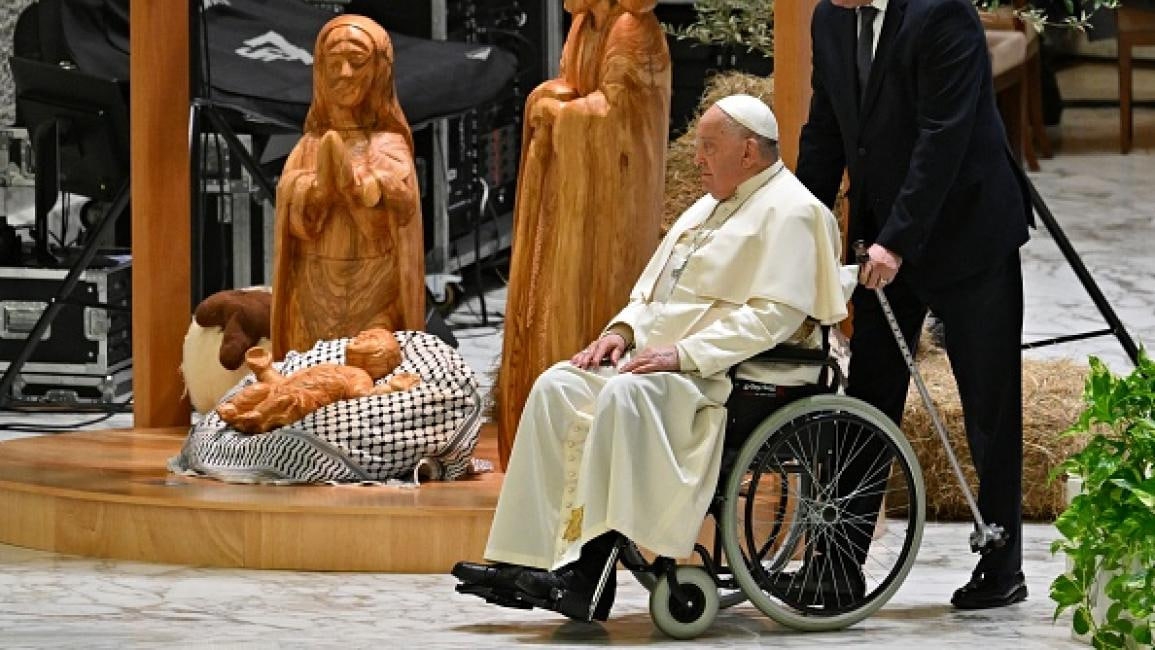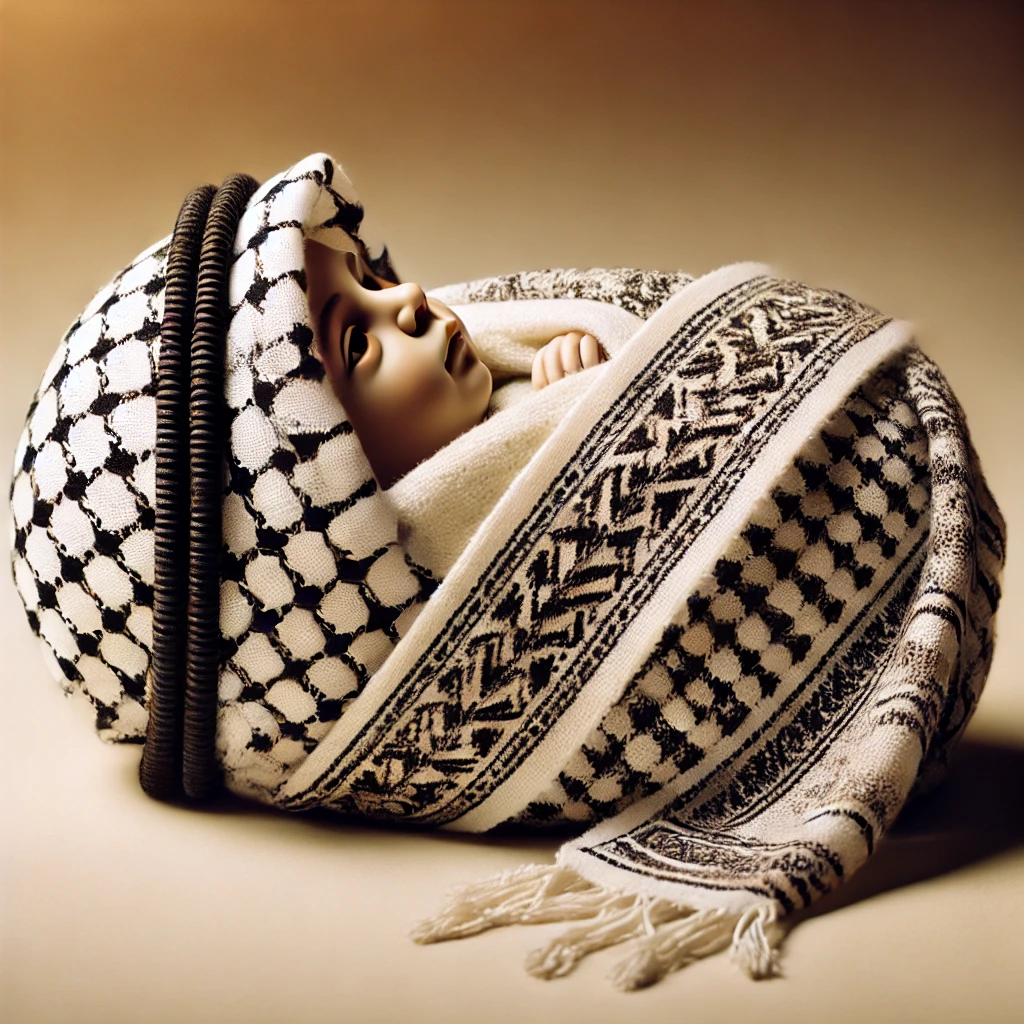Did a nativity scene at the Vatican, meant to symbolize peace, inadvertently ignite a controversy? The recent decision to feature the baby Jesus wrapped in a keffiyeh, a symbol of Palestinian identity, has sparked both praise and criticism, highlighting the complexities of religious expression within a politically charged context.
On Saturday, Pope Francis presided over the unveiling of a seasonal nativity scene at the Vatican. The scene, a collaboration with Palestinian officials, presented a unique interpretation of the Nativity story. Central to this depiction was the infant Jesus, nestled upon a keffiyeh. This traditional Palestinian scarf, instantly recognizable as a symbol of Palestinian national identity, immediately became a focal point of discussion. The scene was inaugurated in St. Peter's Square, a location steeped in tradition and symbolism.
The choice to incorporate the keffiyeh was not made lightly. It was a deliberate act, carrying a message of solidarity and empathy. The scene aimed to bridge cultural divides and convey a message of peace, particularly relevant in the ongoing context of the Israeli-Palestinian conflict. The scene, crafted by Palestinian artists from Bethlehem, included a Bethlehem star with inscriptions in Latin and Arabic: "Glory to God in the highest, and on earth peace, goodwill to all people." These words, intended to be universal in their message of hope, were placed alongside the representation of the baby Jesus.
However, the depiction of the baby Jesus in the keffiyeh has also drawn significant attention. This unusual interpretation, while intended to evoke sentiments of empathy, was not universally embraced. Some observers expressed concern, viewing the keffiyeh as a symbol of Palestinian identity. This perceived politicization of a sacred symbol sparked backlash from certain quarters. The symbolism, however well-intentioned, was perceived by some as carrying a political message. The immediate consequence was the removal of the display from the Paul VI Hall. While the display was intended to represent a universal message of peace, the reality of its reception revealed the inherent sensitivities around the Israeli-Palestinian conflict.
Pope Francis is known for his commitment to fostering dialogue and understanding between people of different faiths and backgrounds. He has repeatedly spoken out against violence and injustice, making his presence a beacon of peace in the turbulent world. His efforts to encourage interreligious dialogue are reflected in his emphasis on human fraternity and the shared values that unite humanity. The unveiling of the nativity scene was consistent with his overarching message of love, compassion, and the importance of building bridges between communities. The Vaticans response demonstrates an awareness of the diverse interpretations and emotions surrounding the imagery chosen for the Christmas season.
The nativity scene, specifically in Paul VI Hall, was a poignant expression of the message of peace and the search for unity. It was created in the tradition of the Nativity scenes, which have long been a staple of Christmas celebrations. The scene, incorporating humble elements and depicting the birth of Jesus in surroundings mirroring the local culture, has deep significance. The location of the nativity scene, in the Paul VI Hall, added further layers of symbolism. Pope Francis has long sought to promote peace and understanding within the global community. His dedication to inclusivity and compassion is well-known.
On the same day that the keffiyeh nativity scene was unveiled, Pope Francis met with the artists and donors who were responsible for creating the Vatican's Christmas decorations. It was a ceremony filled with symbolism and hope. In the wake of the controversy over the nativity scene, the Vatican made the decision to remove the keffiyeh and the infant Jesus from the manger. The swift change underscores the delicate balance involved in addressing complex political and social issues. The Vatican's decision underscores a cautious approach to such matters.
In his address on Saturday, Pope Francis delivered a heartfelt plea for peace. His words resonated with a global audience. He condemned the arms industry that profits from conflict and death, stating, "Enough with wars, enough of violence!" His call for an end to violence reflects his commitment to promoting a culture of peace and his profound belief in the sanctity of life. It was a call for peace that echoed across the globe.
The annual nativity scene is a traditional part of the Vatican's Christmas celebrations. The nativity, is the center of the Christmas spirit. This years scene, however, made it a talking point for various individuals. The unique element, which included the infant Jesus wrapped in a keffiyeh, was supposed to reflect a message of solidarity with the Palestinian people. The image of Jesus resting on the keffiyeh, was intended to communicate compassion and a message of inclusivity. The scene aimed to emphasize the values of peace and brotherhood.
The use of the keffiyeh as a symbol of Palestinian identity is well-documented, and its association with the struggle for self-determination has been part of the political context. The keffiyeh is a symbol of Palestinian identity. It is worn by Palestinians across the world, and its significance extends far beyond its practical use as a head covering. The keffiyehs presence within the nativity scene stirred complex reactions. For some, the incorporation of the keffiyeh served as a poignant reminder of the hardships endured by Palestinians and a call for solidarity with those who have been affected by conflicts. The symbolic representation of Palestinian identity, for example, can be linked to support for Palestinian rights and aspirations.
The swiftness with which the Vatican responded to the criticism is a sign of how delicate the issues involved. The incident highlights the sensitivities that surround the Israeli-Palestinian conflict. It also emphasizes the importance of considering the diverse perspectives that are present. The Vaticans response underscores its awareness of the complexities of this situation. The decision to remove the controversial element of the nativity scene shows a concern for maintaining unity within the Catholic community. The Vatican's response offers a lesson for how to handle a sensitive topic.
The impact of the controversy extends beyond the confines of the Vatican. The event has spurred discussion about the role of religious symbols in the political arena and how cultural references can be interpreted. The nativity scene also serves as a reminder of the need for empathy. The situation at hand stresses the need to consider different interpretations. The incident offers a reminder to listen to all viewpoints.
The scene's design itself, which featured elements of Palestinian culture, aimed to evoke a sense of humility and communion. The message conveyed was meant to be one of inclusivity and shared humanity, as Jesus' birth embodies humility. This is the essence of the Nativity story. The scene created a connection with people of diverse backgrounds and provided a visual representation of unity and peace. Pope Franciss message for the world is "Enough with the wars, enough with the violence!"
The controversy that arose around this display serves as a reminder of the importance of thoughtful discourse. The discussion surrounding the Vatican's Christmas display underscores the need to approach such topics with sensitivity. The inclusion of the keffiyeh was intended to be a symbol of peace, but it opened the door to criticism. It also demonstrates the need for all individuals to be aware of the diverse interpretations that exist. The Vatican is known for its commitment to global understanding.
The nativity scene offers a reflection of the value of compassion. Turning to the nativity scene displayed in Saint Peter's Square, modeled after a traditional "casone" from the Grado Lagoon, Pope Francis observed that these humble fisherman's huts, built with simple materials like mud and reeds, speak to us of Christmas, "when god became man to fully share in our poverty, building his kingdom." This emphasizes the need for inclusivity and brotherhood.
The wooden display showed the baby Jesus lying on a Palestinian keffiyeh scarf. The image of the pope seated in his wheelchair before a nativity scene with the baby Jesus placed on a keffiyeh, stirred mixed reactions on social media. These social media responses have provided a snapshot of how the scene was perceived, revealing both positive and negative sentiment. Reactions vary considerably.
The controversy also brings awareness to the importance of understanding the political context. The events surrounding the nativity scene have served as a call for interfaith dialogue. The controversy is evidence of the importance of creating a world filled with peace. The message of peace delivered by the Vatican is meant to be heard all across the globe.


